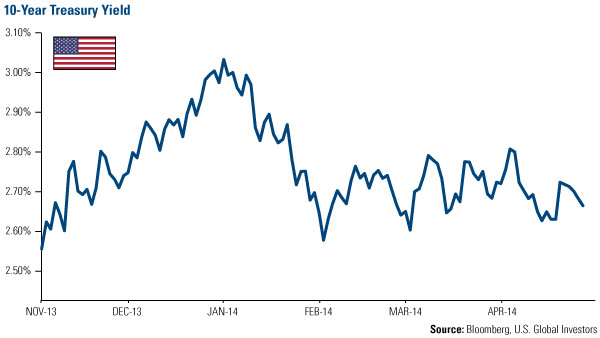The Economy and Bond Market Radar (April 29, 2014)
Treasury bond yields declined this week, pushing the benchmark 10-year yield towards established support levels near 2.6 percent, as unrest between Russia and Ukraine led investors to safer government securities.
Strengths
- The University of Michigan consumer confidence index jumped to 84.1 in April from 80.0 in March. This was the highest reading since July 2013.
- Orders for durable goods increased 2.6 percent in March, the Commerce Department said Thursday. That was the second consecutive month of growth, after declines in December and January. Factory orders for long-lasting goods last month rose by the highest amount since last fall, signaling a brightening outlook for manufacturing and the U.S. economy.
- The initial or "flash" Markit PMI for the U.S. fell slightly to 55.4 in April from 55.5 in March. However, readings over 50 in the purchasing managers' index indicate growth. Also, readings for new orders and exports improved, and production in April rose to its fastest pace since March 2011.
Weaknesses
- Existing-home sales fell 0.2 percent from February to a seasonally adjusted annual rate of 4.59 million, the National Association of Realtors said Tuesday. Sales were down 7.5 percent in March from a year earlier and were at their slowest pace since July 2012.
- The Commerce Department said on Wednesday new U.S. single-family home sales dropped 14.5 percent to a seasonally adjusted annual rate of 384,000 units, declining for a second consecutive month and the lowest level in eight months.
- Initial U.S. jobless claims rose 7.9 percent to 329,000 for the week ending April 19, according to a Labor Department report released Thursday. The gain likely reflected temporary layoffs in the week before Easter.
Opportunities
- The Fed has reiterated its intention to not raise interest rates before economic data supports that decision, not based on a timeline.
- The President of the European Central Bank (ECB), Mario Draghi, suggested the ECB may ease monetary policy in response to the strong euro.
- There are many moving parts to the taper decision and while the Fed began the process, it is very possible that tapering could be delayed if the economy stumbles.
Threats
- In addition to the inherent difficulties in exiting the QE program and the potential for a misstep, there is also the potential for miscommunication from the Fed with the recent change in Fed leadership.
- Trade and/or currency “wars” cannot be ruled out which may cause unintended consequences and volatility in the financial markets.
- China remains a wildcard for economic recovery and the economy has shown some cracks in recent months. This is similar to how last year started and China found its footing, something similar needs to happen this time around.

















